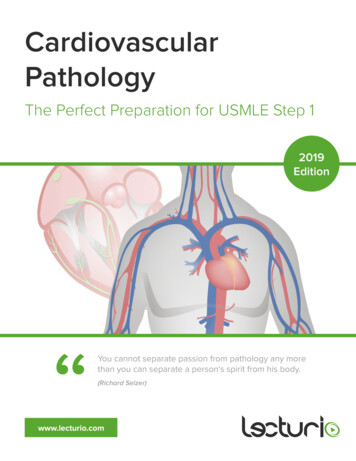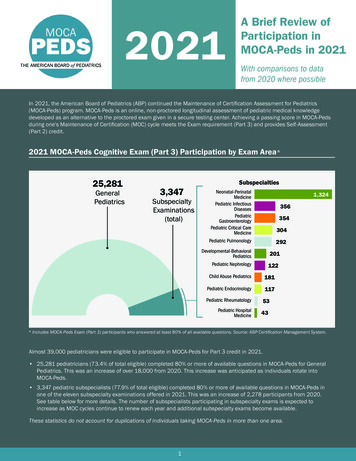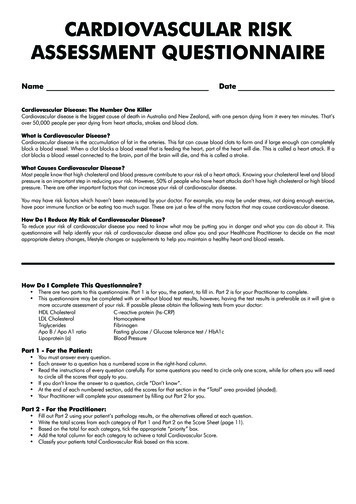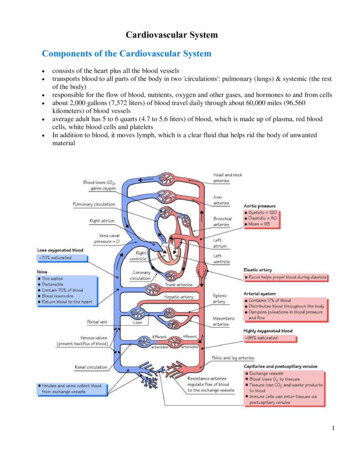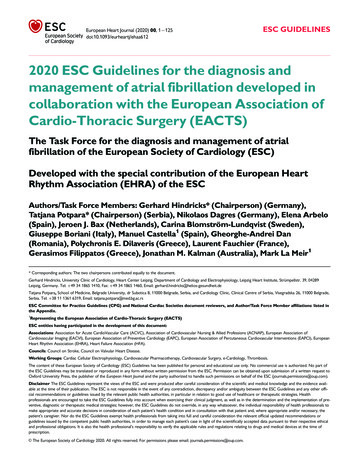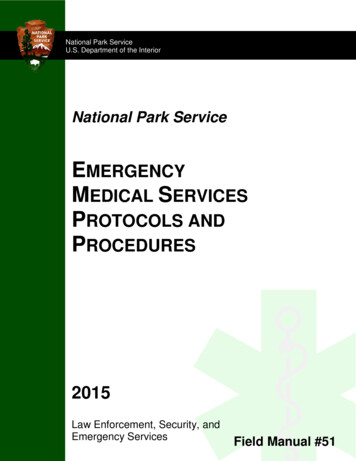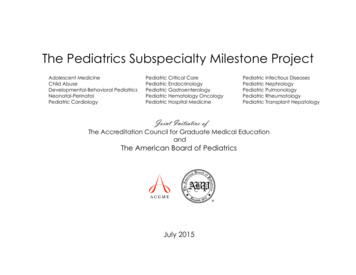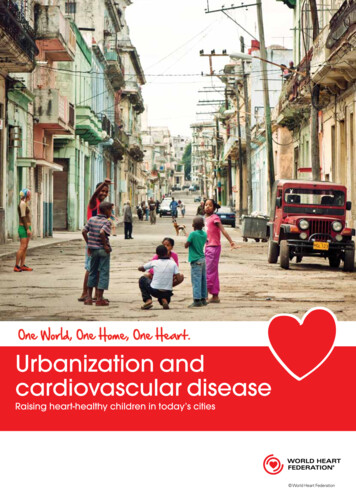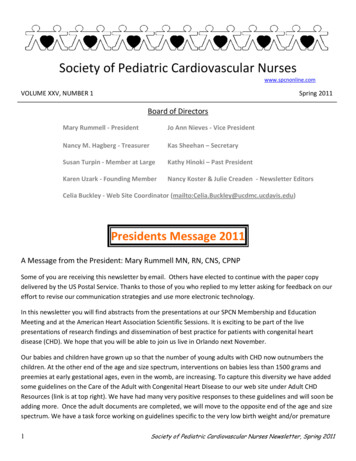
Transcription
Society of Pediatric Cardiovascular Nurseswww.spcnonline.comVOLUME XXV, NUMBER 1Spring 2011Board of DirectorsMary Rummell - PresidentJo Ann Nieves - Vice PresidentNancy M. Hagberg - TreasurerKas Sheehan – SecretarySusan Turpin - Member at LargeKathy Hinoki – Past PresidentKaren Uzark - Founding MemberNancy Koster & Julie Creaden - Newsletter EditorsCelia Buckley - Web Site Coordinator (mailto:Celia.Buckley@ucdmc.ucdavis.edu)Presidents Message 2011A Message from the President: Mary Rummell MN, RN, CNS, CPNPSome of you are receiving this newsletter by email. Others have elected to continue with the paper copydelivered by the US Postal Service. Thanks to those of you who replied to my letter asking for feedback on oureffort to revise our communication strategies and use more electronic technology.In this newsletter you will find abstracts from the presentations at our SPCN Membership and EducationMeeting and at the American Heart Association Scientific Sessions. It is exciting to be part of the livepresentations of research findings and dissemination of best practice for patients with congenital heartdisease (CHD). We hope that you will be able to join us live in Orlando next November.Our babies and children have grown up so that the number of young adults with CHD now outnumbers thechildren. At the other end of the age and size spectrum, interventions on babies less than 1500 grams andpreemies at early gestational ages, even in the womb, are increasing. To capture this diversity we have addedsome guidelines on the Care of the Adult with Congenital Heart Disease to our web site under Adult CHDResources (link is at top right). We have had many very positive responses to these guidelines and will soon beadding more. Once the adult documents are completed, we will move to the opposite end of the age and sizespectrum. We have a task force working on guidelines specific to the very low birth weight and/or premature1Society of Pediatric Cardiovascular Nurses Newsletter, Spring 2011
babies. Check out the adult documents on our web site: www.spcnonline.com. We welcome all commentsand suggestions – and volunteers to join the members continuing to work on the development of thedocuments at both ends of the life span.The other exciting role for SPCN is the inclusion of our organization in the Institute of Pediatric Nursing (IPN).Of the 3.1 million registered nurses only 10% or 313,759 RNs care for infants and children and only 33,000advanced practice nurses provide pediatric care. Because of this small proportion of nurses involved in thecare of children, the IPN was conceived as a collaborative of 20 pediatric organizations to advocate forimproved health care for all children. SPCN was invited to participate in the second invitational meeting heldin November 2010. The web link is www.ipedsnursing.org if you would like to see the member organizationsand read about the invitational forums.The mission statement of the IPN is “to create a healthy future for our nation through a unified network ofpediatric nursing organizations working through education, research, and practice to secure child and youthwell-being.” The common areas of concern that were identified at the first meeting and built upon at thesecond included: access to pediatric professional care; advocacy; care coordination; pediatric nursingeducation; and safe, quality, evidence based care. The goals and professional practice of SPCN memberssupport all of the identified areas of concern, especially the areas of advocacy, care coordination and safe,quality, evidence based care. We will add the results of the membership surveys many of you have sent andanswered as one way to share evidence based care. We would love to share your successes and include yourwork in these other impact areas. Please send items for the newsletter to either of our two new newslettereditors: Nancy Koster at nkoster@childrensmemorial.org , Julie Creaden at jcreaden@childrensmemorial.org ,or myself at rummellm@ohsu.edu.Keep up your excellent work in promoting and providing health care to children – of all ages and sizes!SAVE THE DATE2011 SPCN Meeting: NOVEMBER 12, Orlando, FloridaContact SPCN if you'd like to suggest educational topics of interest. If you can not make the meeting, join us for agroup dinner Saturday evening - immediately following.Thank you to Sheryl Leo RN, CCRN, ANM & the Arnold PalmerChildren's cardiac program for their help!2Society of Pediatric Cardiovascular Nurses Newsletter, Spring 2011
SPCN Business Meeting Minutes2010Secretary:1.Minutes of 2010 meeting reviewed and approved.Membership Summary:o 380 domestic members, 33 international in database, for total of 413 members.o 113 members last paid dues in 2008-2009 and are currently lapsed.o 262 paid for last year (2009-2010), 91 have renewed so far for this year beginning Nov. 1st.o In 2009-2010 there were 33 new members and 25 new members so far in 2010.Treasurer:Expenses were mostly for directory and postage for newsletter/directory.Website:Adult with CHD info has been added. Fees for web editor are increasing.Membership Communication Discussion: discussion ensued regarding electronic communications vs.print/US mail. Many present seemed to be in favor of becoming more ‘electronic’. Various ideas posedrelated to having a list serv for members to access and check info on website, access directory via website,sending newsletter via e-mail, and doing renewals via web site. Discussion included need to protect memberprivacy if directory placed there to make it accessible to members only – password protected and ability tomake changes themselves.Consensus was that both electronic and print are still needed but that the members should be polled to seewhat preferences are. The board will discuss tomorrow at board meeting and develop a plan to communicateto the members to determine preferences. Also, there was a need voiced to check on easier ways formembers to renew such as PayPal, auto renew, etc. Nancy Hagberg will investigate options.2.Collaborative Ventures: 6th World Congress; South Africa 2013 – Sandy Staveski has not heard from committee yet and willfollow up. ACC – Liz Tong reports that there is increased recognition of nursing in participation in ACC initiativesand annual meeting. There is also the Nursing metric workgroup headed by Liz and Jean Connor withmany SPCN member participants – collecting data on nursing metric regarding nutrition in infants withCHD. Much more support for nursing and increased exposure during next ACC meeting April 2-5 inNew Orleans. PCICS – Pediatric Cardiac Intensive Care Society – Sandy Staveski and Dottie Beke are nursing liaisonsand there is a strong nursing component for the meeting in December in Miami, throughout the entire4 days as well as an APN pre-program. Institute of Pediatric Nursing - Mary Rummell and Pat O’Brien represented SPCN at recent meeting.Also at the table were reps from APN certification boards, 4 children’s hospitals, SPN, SPON (oncology),Diabetes, school nurses. The focus is on promoting pediatric nursing and education.3.3AHA Councils: Nursing Research Session – Being held on Tuesday Nov, 16th. Program has been developed by AngelaGreen and Jean Connor. Lunch is being provided by Children’s Hospital Boston. There was discussionSociety of Pediatric Cardiovascular Nurses Newsletter, Spring 2011
regarding support of this luncheon which is AHA focused, by SPCN (in past years it was funded fully bySPCN) with possibility of either designating set amount each year, or to use SPCN funds to increasesupport of current SPCN educational meeting on Saturdays and incorporating more research.Suggestion that use of funds may be better served to send SPCN reps to meetings such as the Instituteof peds nursing, etc. Jean Connor proposed gaining support from individual institutions/hospitals byincreasing awareness of SPCN and involvement of their staff in SPCN, therefore getting institutionalsupport for this annual luncheon. Other discussion included individuals paying own way, etc. Theseideas would be explored. Peds CVN Council – Deb Hanisch continues to serve as chair for this sub-committee. She gave updates:Topics this year – Overview of program topics that were developed from this committee beingheld this year in conjunction with CVDY.AHA Scientific Statements on 1) Adolescents with CHD transition to adulthood and 2)Neurodevelopmental outcomes in CHD are under peer review. Work is currently being done on3) Prevention & treatment of Thrombosis in Children – hopefully to be out next year. Congratulations! Deb Hanisch on her induction as new FAHA member this year.TOPICS DISCUSSED AT AHA AND SPCNMEETINGS THIS YEAR:Ideas included dental care, re-submit previous ideas to AHA on heart failure in infants and children,psychosocial issues and quality of life. Other suggestions and ideas are welcome.JoAnn Nieves will coordinate organization of education program for SPCN in Orlando next year and work withOrlando nurses and Kas Sheehan in planning for meeting.Respectfully submitted by Kas Sheehan, Secretary.4Society of Pediatric Cardiovascular Nurses Newsletter, Spring 2011
The Society of Pediatric Cardiovascular Nurses, Inc.Treasurer’s ReportNancy M. Hagberg, TreasurerNovember 1, 2009 to October 31, 2010Start (11/1/09)Bank of America Account Balance14,717.59Year End (10/31/10)Bank of America Account esConference and FoodIncorporation FeePostagePrintingNewsletterDirectoryWeb MaintenanceRegistration: Institute of Pedi .00350.00FY Total for Mailing and Printing 6544.25Need 327 members to break even for mailings at 20 membership feeFiscal Year Renewals were 155 memberships.5Society of Pediatric Cardiovascular Nurses Newsletter, Spring 2011
6Society of Pediatric Cardiovascular Nurses Newsletter, Spring 2011
SPCN Business Meeting MinutesNovember 13, 2010Children’s Memorial HospitalChicago, IllinoisAGENDA2:00 – 2:30 pm2:30 – 2:40 pm2:40 – 4:00 pm4:00 – 4:30 pm4:30 – 6:00 pmRegistration/RefreshmentsWelcome/Introductions – Large turnout this year. There were 30 attendees.Acknowledgement of Hosts and Planning committee:Thanks to Children’s Memorial Hospital – via member Julie Creaden for hostingand providing refreshments. Thanks to JoAnn Nieves for planning theeducational program.Educational ProgramBreakBusiness MeetingPresident – Mary RummellSecretary – Kas SheehanMember at Large – Susan TurpinVice President – Joann NievesNewsletter editor Jenny Strawn has stepped down. Julie Creaden & Nancy Koster have volunteered to takeover as newsletter co-editors.Web site coordinator Gwen Fosse has stepped aside and Celia Buckley has volunteered to take over the website.7Society of Pediatric Cardiovascular Nurses Newsletter, Spring 2011
Administration of Adenosine:Who, Where, What?Mary Rummell, MN, RN, CWS, CPNPIn our effort to standardize our care of the pediatric patient with tachycardia, I sent out a questionnaire to theSPCN membership. In our hospital some felt that the patient should be moved to the PICU and only ICU RNs orphysicians should administer the medication. The results of this questionnaire supported a change of practicein our facility.Twenty responses were received from 17 different hospitals, including Great Ormond Street Hospital forChildren, London, UK and The Hospital for Sick Children, Toronto, ON, Canada. The results are as follows:o Who may administer adenosine? Only one hospital limited the administration to a physician. An equalnumber of responses identified that a registered nurse with or without PALS certification, an intensivecare or transport nurse, or a physician could administer the medication.o Who needs to be present? Everyone indicated that an attending physician (cardiologist, cardiacsurgeon, or ICU attending) or cardiology fellow needed to be present. Only one facility felt that an ICUor transport nurse needed to be present.o What monitoring is needed? All indicated that the patient needed to be on a monitor, eithercardiac/respiratory or transport monitor with a printer. Sixty percent also felt that the patient shouldbe on an oxygen saturation monitor.o Where adenosine may be administered? Only two hospitals felt that adenosine needed to beadministered in the ICU or emergency department. The rest felt that it could be administered to apatient who needed the medication anywhere the patient was located as long as the requiredmonitoring and personnel were present.Only 5 hospitals had a specific policy/procedure. In Great Britain, the standards are national standards.2010 American Heart Association Sessions Chicago, IllinoisSPCN Multicenter Study: Podium PresentationStress and Uncertainty as Perceived by Parents of Infants Dischargedfollowing the Norwood OperationE. Marsha Elixson, Children’s Healthcare of Atlanta, Atlanta, GA; Sandra Staveski, Lucile Packard Children’s Hospital at Stanford,Stanford, CA; Jo Ann Nieves, Miami Children’s Hospital, Miami, FL; Jennifer Strawn, Children’s Hospital, Omaha, NE; Cathy Smith,Arnold Palmer Hospital, Orlando, FL; Yu Wang, Children’s Hospital Medical Ctr, Cincinnati, OH; Karen Uzark, Children’s HospitalMedical Ctr, Cincinnati, OH.Following discharge after the Norwood operation, Survival remains uncertain.There continues to be a 10-15% or higher incidence of interstage death in these babies before the stage II surgicalpalliation8Society of Pediatric Cardiovascular Nurses Newsletter, Spring 2011
Caregivers of infants with complex single ventricle may experience significant stress related to uncertainty concerningtheir infant’s heart condition and care needs following the Norwood operation. To better understand the stressexperienced by these families, we assessed parental uncertainty stress and its relationship to patientcharacteristics/outcomes.Methods: As part of a multicenter study of feeding practices and weight gain, parents completed the Mishel ParentalPerception of Uncertainty scale (PPUS) pre-discharge (n 99) and at 4 wks (n 78) and 12 wks (n 63) post discharge (DC).The PPUS contains 4 subscales: Ambiguity, Lack of Clarity, Lack of Information (Info), and Unpredictability, with a 5-pointLikert response format. Data collection began in 2005 and was completed December, 2009.Results: With higher scores higher uncertainty, PPUS scores were highest related to Unpredictability at all time points(mean/SEM 3.14/.07 pre DC, 2.92/.07 at 4 wks, 2.81/.10 at 12 wks) and lowest related to Lack of Info (mean/SEM 1.67/.05, 1.68/.06 at 4 wks, 1.69/.06 at 12 wks). There was no significant change in PPUS total or subscale scores overtime except Unpredictability which significantly decreased from pre-DC to 4 wks post DC (p .01). PPUS scores post DCwere not significantly correlated with hospital length of stay (HLOS), a potential surrogate for illness severity. Parents ofinfants fed orally only (n 40) had higher scores for Unpredictability at discharge than parents of infants with any/all tubefeeding (n 59), p .01. Higher weight gain between 4 to 12 wks was associated with lower Lack of Information score atwk 12, rs -.39, p .01.Conclusion: Parents of infant survivors following Norwood operation experience persistent stress following DC,unrelated to HLOS, though perceived unpredictability decreases following DC. Parents of orally fed infants perceivedgreater unpredictability pre-discharge. Infants of more informed parents had better weight gain. Surveillance andincreased communication of information, especially related to feeding in this study, may decreased parental uncertaintystress and assist parents in caring for their infants following Norwood operation.SPCN extends a very special thanks to Dr. Karen Uzark for her development, leadership and continued work in thismulticenter project.Podium Presenter: Jo Ann Nieves, Miami Children’s Hospital, Miami, FLInterventions to Improve the Quality of Life of Children and Adolescents with ICDsVicki L. Zeigler, PhD, RNAccording to the World Health Organization (WHO), quality of life is defined as “the product of the interplay betweensocial, health, economic, and environmental conditions which affect human and social development’ (WHO, 2004).Having an implantable cardioverter defibrillator (ICD) in childhood and/or adolescence has a profound effect on thequality of life of these recipients, yet very little research has focused on this patient population. The available literaturehas indicated that children and adolescents with ICDs experience decreased physical functioning when compared totheir healthy peers as well as a greater need for social acceptance (DeMaso, et al 2004). Data have also revealedsignificant correlations between quality of life and measures of anxiety, depression, and family functioning. A studypublished by Costa and colleagues (2007) revealed that excessive shocks, both appropriate and inappropriate resulted indecreased quality of life in young patients with ICDs when compared to their healthy counterparts. Other researchershave delineated similar findings including social isolation and risk for depression (Zeigler & Nelms, 2009), as well as fearof being shocked, sports participation/activity restrictions, and peer acceptance (Zeigler & Decker-Walters, 2010). All ofthese findings indicate that the quality of life for these individuals is greatly impacted by device placement.9Society of Pediatric Cardiovascular Nurses Newsletter, Spring 2011
Despite these findings, no intervention studies to improve quality of life have been found in the literature to date.Several potential interventions have been identified from the available literature and include the following targetedareas: (1) patient and family education, (2) ventilation sessions for children and adolescents, (3) the shock experience,(4) sports participation/activity restrictions, (5) depression, and (6) social isolation. With respect to patient and familyeducation, patients and their families should receive as much information as possible about the indications for the ICD,what the ICD does and what to expect, and the rationale for sports and activity restrictions. Children and adolescentsshould be encouraged to discuss how they feel about having the device with their healthcare providers as well as theirfamilies and friends.With regard to the shock experience, healthcare providers should develop strategies to decrease the number ofinappropriate shocks, including the optimization of programmable features and the management of lead and/or devicerecalls. In order to lessen the impact of sports participation and activity restrictions, providers should assist theirpatients in finding acceptable alternatives. Partnering with schools, especially with school nurses, guidance counselors,and coaches, could prove very beneficial. Healthcare providers should remain cognizant of the risk of depression,especially with patients who receive concomitant beta blocker therapy; periodic screening for early intervention couldgreatly improve quality of life in these individuals. Social isolation could be reduced by implementing a “buddy system”in which new ICD recipients are paired with existing patients based on age and gender for ongoing communication.Other strategies for improving their quality of life include social support networks and summer camps for ICD recipientsand their families. For the future, more research is needed to develop and test interventions aimed at increasing qualityof life in this patient population. This research should be collaborative, multidisciplinary, and involve multiple centerswho care for these patients and their families.Interdisciplinary program to optimize care coordination and delivery in youngchildren requiring a VAD.Sandy Staveski RN, MS, CPNP-PC, CPNP-AC, CNS, CCRN, Cardiovascular ICU Nurse Practitioner, BOuNCE Program ManagerLucile Packard Children's Hospital at StanfordBackground: Young children supported on a ventricular assist device (VAD) can have prolonged hospitalizations awaitingheart transplantation. The adult VAD literature demonstrates that comprehensive programs optimize transplantationoutcomes. The goal of this intervention was to create an interdisciplinary program to optimize care coordination anddelivery in young children requiring a VAD. Method: This study was a case review. Results: We have supported 8 infantsand young children with Berlin Heart VAD. These children’s hospitalizations have been more complex than those of ourolder VAD patients, and they have required intensive care for prolonged periods. An interdisciplinary group evaluatedour practices and identified areas for potential improvement. The focus group from our intensive care unit introducedmultiple interventions to optimize interdisciplinary care coordination and consistency of practice. These included (1)interdisciplinary care guidelines for chronically, critically ill patients; (2) institution of a primary cardiovascular intensivecare unit(CVICU) physician and nurse practitioner system; (3) introduction of a psychological intervention for families to minimizethe impact of their extended CVICU stay; (4) implementation of early jejunal feeds; (5) a focused developmental andrehabilitation protocol, 6) implementation of a structured approach to minimizing blood transfusions; (7) increasedstructure for our interdisciplinary rounds to optimize team communication; (8) comprehensive nursing educationincluding wound care, anticoagulation management, and laboratory draws; and (9) a protocol for off-unitrehabilitative/developmental interventions. These changes in both practice and approach for young VAD patients havealso been of benefit to other chronically, critically ill children in the CVICU, as well as to our CVICU team. Conclusion:10Society of Pediatric Cardiovascular Nurses Newsletter, Spring 2011
Comprehensive interdisciplinary care coordination and standardized practice can be achieved in the critical care settingfor complex pediatric heart failure patients who require long-term VAD support.The Postoperative Stage I Infant: Challenges in the ICULisa Kohr, RN, MSN, CPAP-PC/AC, MPHSince the mid 1990s, mortality rates for infants with hypoplastic left heart syndrome (HLHS) have steadily declined dueto advances in medical and surgical care. Yet, despite these improvements, clinicians are still faced with the samepostoperative challenges encountered by their predecessors but in the context of younger, smaller and more complexpatients. With improved survival, comes a greater knowledge of how to improve the care at the bedside to decreasemorbidity. Now the focus of ICU care has broadened from improving survival to optimizing the quality of life for theseinfants.The Norwood procedure with the placement of a modified Blalock-Taussig shunt has been the main surgical palliationfor infants with HLHS; however, it is associated with high operative mortality, morbidity and interstage death. Recently,many centers have begun to routinely use the Sano modification which employs the placement of a right ventricle topulmonary artery nonvalved conduit to provide pulmonary blood flow for the Norwood procedure. The main benefits ofthe Sano modification have been reported to include less variable shifts in vascular resistance which allows for earlierpostoperative stabilization in the ICU and the avoidance of diastolic runoff and coronary steal during systole which mayimprove interstage attrition.Challenges faced by bedside providers in caring for the postoperative Stage I Infant are multisystem. Some infants maybe at higher risk due to their gestational age and birth weight, preoperative health status, length of cardiopulmonarybypass and circulatory arrest, presence of arrhythmias, bleeding, and the development of renal dysfunction.Postoperative cardiovascular issues include: recognizing and attenuating the effects of cardiopulmonary bypass,optimizing cardiac output, achieving a pulmonary to systemic to pulmonary blood flow ratio that is close to 1 in order toachieve a balanced circulation and identifying the cause of decreased systemic or decreased pulmonary perfusion. Gasexchange may be altered due to endothelial dysfunction, pulmonary overcirculation, immature lungs, or elevated PVR ina patient with a preoperative intact atrial septum. Early extubation should be the main goal although this may behindered by microatelectasis, phrenic nerve injury or persistent effusions. Short-term interventions that will impactlong-term care include preventing exacerbation of neurologic injury and promoting early enteral feedings.Decreased mortality in this population has raised the bar for expected outcomes in this population. Mechanical supportand new medical therapies have allowed clinicians to push the boundaries of care for infants following the Stage Iprocedure. The adoption of nationally endorsed standards such as central line-associated bloodstream infectionprotocols has decreased some ICU risk factors. Long-term follow-up has also informed care provided at the bedside.However, multicenter randomized control trials are needed to identify best practices for managing low cardiac output,enteral feeding initiation, sedation titration, and neuroprotective strategies outside the operating room.11Society of Pediatric Cardiovascular Nurses Newsletter, Spring 2011
Infant CPR Anytime: Self-Instructional CPR Training for Parents ofHigh Risk Infants.Trudy A. Pierick, ARNP, Inpatient Nurse Practitioner, Pediatric Cardiology, University of Iowa Children's HospitalObjective: Premature infants (PRE)and infants with congenital heart disease (CHD) have a high risk of respiratory orcardiac arrest within the first year. Bystander CPR is a major predictor of resuscitation outcome. The purpose of thisstudy was to assess usefulness of a self-instructional DVD kit (Infant CPRAnytime ) for families of high risk infants. Wehypothesized that comfort level of providing CPR would increase, the kit would be shared with other caregivers andwould be reviewed at regular intervals.Methods: Parents of PRE infants ( 35 wks or 2500 gms) or with CHD were given a self-instructional CPR kit. One parentcompleted a questionnaire, reviewed the DVD, and practiced CPR before discharge. The parent was asked to share thekit with other care providers, practice CPR every 3 months and respond to questionnaires at 4 and 12 month intervals.The questionnaire surveyed prior CPR training, comfort level doing CPR on their child, plans to share the kit with othercare providers and plans to review the kit. The 4 and 12 month surveys assessed comfort level performing CPR (5 pointLikert scale), number of additional persons who reviewed the kit, and how often the kit was reviewed by the parent.Results: We enrolled 311 parents: 238 in the PRE group and 73 in the CHD group. Seventy-five percent of parents hadprior CPR training. The kit was shared with 2.8 additional persons and was reviewed by the parent 1.8 times over the 12month interval. Comfort level increased from 2.822 at baseline to 3.348 at 4 months to 3.519 at 12 months (p value of0.0281). There were 8 reported events with need for rescue: choking (3) and CPR (5). All events requiring CPR were ininfants with CHD. Six infants survived the event. Parents of these infants indicated that the CPR training was very useful.Conclusions. There was a significant increase in caregiver comfort level at 4 and 12 months compared to baseline,despite a high level of prior CPR training. There was a marked multiplier effect for the number of persons trained. Easilyavailable self instruction provides an excellent method of CPR training for parents of high risk infants and likelycontributed to a high survival rate. Family caregivers recognize Infant CPR Anytime as a useful method of learning CPRskills.Fall Newsletter submissionsPlease send any submissions for the fall newsletter to Nancy Koster and Julie Creaden byAugust 1, nsmemorial.orgConsider submitting advertisements, program updates and any othernewsworthy information.12Society of Pediatric Cardiovascular Nurses Newsletter, Spring 2011
Improving Access to Cardiac Care through the Development of aHigh Acuity Transition (HeArT) ClinicJulie Ann Creaden CPNP, MSN, RN, Jeffrey G. Gossett MD, Amy Lay MD, Nguyenu Nguyen MD, Tania Saroli MD.Division Cardiology, Children’s Memorial Hospital, Chicago, ILAbstractBackground: Infants and children with congenital heart disease require diligent and extensive follow-up throughouttheir lives, particularly those who are born with single ventricle physiology and hypoplastic left heart syndrome. In orderto achieve a more efficient in-series circulation in these children, they must undergo three palliative operations(Norwood, bidirectional Glenn, and completion Fontan) and because of the interim gap between surgical interventions,these children are at high risk for interstage morbidity and mortality. Children with highly complex single ventricleanatomy also require more frequent clinical visits and are more likely to be readmitted to the hospital betweenprocedures. At our institution we identified a gap in care and delay of scheduling based on filled clinic spots for newlydiagnosed complex cardiac patients and high acuity postoperative cardiac surgical patients. As part of the NationalPediatric Cardiology Quality Improvement Collaborative (NPC-QIC), a Joint Council on Congenital Heart Disease (JCCHD),we developed the High Acuity Transition Clinic (HeArt), a model to ensure expedited care for our patients with singleventricle anatomy and hypoplastic left heart syndrome. In addition we included fragile patients who need to be seen ona frequent basis for monitoring prior to surgical intervention or postoperatively related to ongoing issues requiringfrequent assessments and evaluation.MethodsWe utiliz
3 Society of Pediatric Cardiovascular Nurses Newsletter, Spring 2011 Society of Pediatric Cardiovascular Nurses Newsletter, Spring 2011 Secretary: Minutes of 2010 meeting reviewed and approved. 1. Membership Summary: o 380 domestic members, 33 international in database, for total of 413 members. o 113 members last paid dues in 2008-2009 and are currently lapsed.
